Plant growth and development : Notes and Study Materials -pdf
- Concepts of Plant growth and development
- Plant growth and development Master File
- Plant growth and development Revision Notes
- Plant growth and development NCERT Book
- NCERT Solution Plant growth and development
- NCERT Exemplar Solution Plant growth and development
- Plant growth and development: Solved Example 1
- Plant growth and development: Solved Example 2
Plant Growth and Development Class 11 Notes Biology Chapter 15
Topics and Subtopics in for Class 11 Biology Chapter 15 Plant Growth and Development:
| Section Name | Topic Name |
| 15 | Plant Growth and Development |
| 15.1 | Growth |
| 15.2 | Differentiation, Dedifferentiation and Redifferentiation |
| 15.3 | Development |
| 15.4 | Plant Growth Regulators |
| 15.5 | Photoperiodism |
| 15.6 | Vernalisation |
| 15.7 | Summary |
NCERT SolutionsClass 11 BiologyBiology Sample Papers
All plant organs are made up of various kinds of tissues which occupy specific locations within an organ and perform specific designated functions. Thus, the development of a plant follows a very precise pattern, during this period complex body organisation is formed, i.e., produces, roots, leaves, branches, flowers, fruits, seed which finally dies.
Topic 1 Growth, Differentiation and Development
The life of a plant initiates from a single cell called zygote. All the structures of plants such as roots, stems, leaves, flowers, fruits and seeds arise from a single cell in a very orderly sequence.
Growth
It is regarded as an essential, fundamental and one of the most conspicuous characteristics of a living being. Growth can be defined as a dynamic, irreversible permanent increase in size of an organ, its parts or even an individual cell.
The growth is generally accompanied by the metabolic processes, i.e„ anabolic and catabolic reactions occurring in an organism (mainly protein synthesis). Thus, growth in living organism is an intrinsic phenomenon (unlike, non-living organisms in which growth is extrinsic).
Plant Growth Generally is Indeterminate
Growth of plant is unique as they retain the capacity for unlimited growth throughout their life. In plants the growth is generally confined only to the meristematic tissues present at certain locations in the body. Meristems in the plant have certain cells that have the capacity of dividing and self-perpetuation.
The new cells produced by the action of division of meristematic cells, soon loose, the ability of dividing and make up the plant frody.
The form of growth in which newly producing cells are always being added to the body erf the plant by the activity of meristems is called open form of growth.
I If the meristem ever ceases to divide, the growth of I the plant will not occur and they may undergo a j period of dormancy depending upon the seasonal j changes in the climate.
Regions of Growth
Apical, lateral and intercalary are the special regions, where growth is localised in plants.
At the apex of every root and shoot apical meristems are present which are responsible for the elongation of plant along their axis. This is known as primary growth of the plant.
Note:
* A meristematic tissue consists of a group of cells, which remain in active and continuous state of division, and they retain their power of division. It consists of immature, living,
thin-walled cells, which are rich in cytoplasm.
* In the mature plant, meristem is also found in intercalary and lateral regions. .
The lateral meristems, vascular cambium and cork cambium appear later in life in dicotyledonous plants and gymnosperms and are responsible for the increase in the girth of the stem. This increase in girth is known as secondary growth of the plant.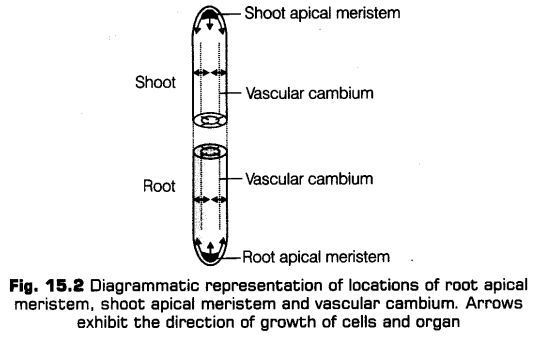
Growth is Measurable
As stated that at cellular level, growth is the consequence of increase in the amount of protoplasm. It is difficult to measure the increase in the protoplasm directly, so it can generally be measured by measuring some quantity of it that is more or less proportional to it.
Hence, growth can be easily measured by a variety of parameters such as
(i) Dry weight (ii) Fresh weight
(iii) Length (iv) Area
(v) Volume (vi) Cell number
Growth can be expressed in terms of increase in the cell number, e.g., Single root apical meristem in maize which give rise to more than 17,500 new cells per hour.
It can also be expressed as an increase in the size of the cell, e.g., Cells in watermelon increases about 3,50,000 times per hour.
Growth can be measured in terms of its length, e.g., Pollen tube and can also be measured in terms of surface area, e.g., In a dorsiventral leaf.
Phases of Growth
Under favourable conditions, growth of plant shows a characteristic course. The period of growth is generally divided into three phases.
All three phases can be easily understood by taking the example of root tip.
i. Meristematic Phase
The cells that are constandy dividing, i.e., both at the apex of the root and shoot represents the meristematic phase of growth.
Features shown by this phase are
* rich in protoplasm.
* has large conspicuous nuclei.
* cell walls are primary in nature.
a thin, cellulosic, has plasmodesmatal connections.
This phase is also known as division phase.
ii. Elongation Phase
This phase lies just behind the growing parts, i.e., behind the meristematic zones away from the tip.
Features shown by this phase are
* increased vacuolation.
* enlargement of cell.
* deposition of new cell wall.
Enlargement of cell during this phase occurs in all direction. Maximum elongation is seen in conducting tissues and fibres.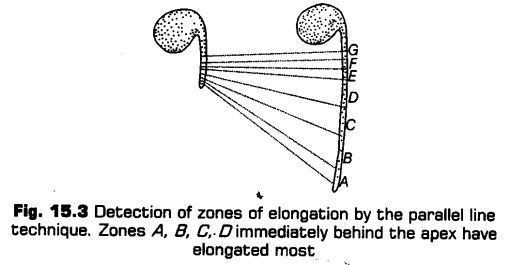
iii. Maturation Phase
Just behind the phase of elongation, occurs a phase of maturation. It occurs further away from the apex, i.e., more proximal to the elongation phase.
Features shown by this phase are
* cells attain maximum thickening of their wall.
* protoplasmic modifications are maximum.
Growth Rate
The growth rate is defined as the increased growth per unit time. Rate of growth can be expressed mathematically. It shows increase that may be arithmetic or geometrical in nature.
i. Arithmetic Growth
Somatic cells increases in number due to mitosis. In this type of growth, following mitotic cell division, only one daughter cell continues to divide, while others follow differentiation and attains maturity.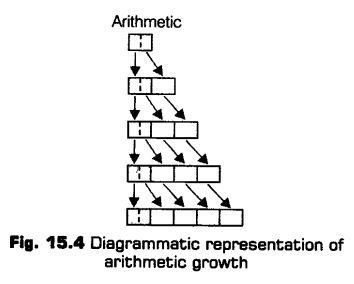
Expression of arithmetic growth can be exemplified by a root elongating at a constant rate. A linear curve is obtained on plotting the length of root against time.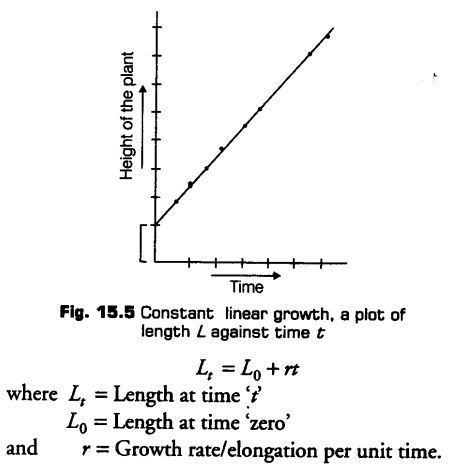
ii. Geometrical Growth
In living organisms, during geometric type of growth rate, pattern follows three important phases
(a) Lag Phase (initial or the beginning phase) It is mainly characterised by very slow growth.
(b) Log Phase (exponential phase) It is the middle phase of the system and is characterised by very fast and rapid growth of the plant body. After initiation of growth, it increases rapidly at an exponential rate.
During this phase, both progeny cells undergoing mitotic cell division retain the ability to divide and continue dividing till the next phase appears till the time nutrient supply is appropriate.
(c) Stationary Phase (steady phase) This phase occurs when either the plant reaches maturity or the supply of nutrients become limited. Due to these mentioned factors, the growth of the plant slows down to come to a halt.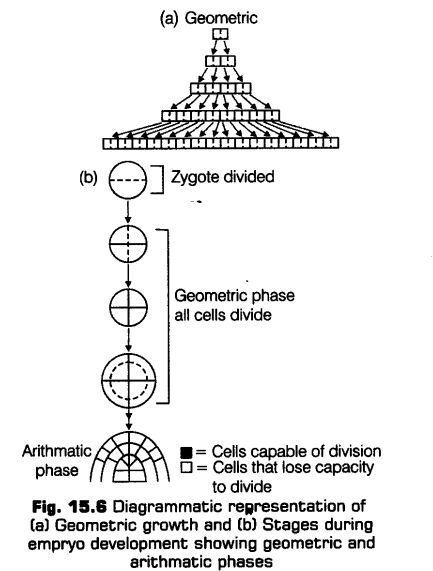
Under favorable conditions, the characteristic course of growth is observed. Thus, if we plot the parameter of growth rate against time, the typical shaped, a sigmoid curve is seen.
It shows a characteristic feature of all living organism growing in a natural environment. This curve is typical for all cells, tissues and organs of a plant.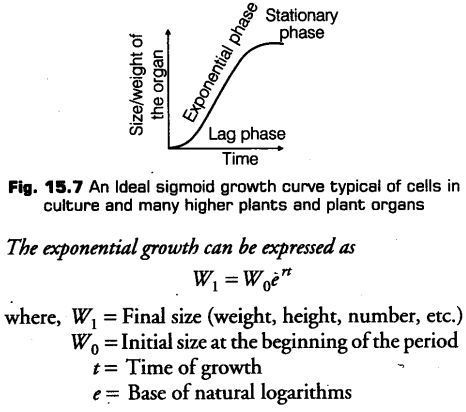
and, r — relative growth rate that measures the ability of the plant to produce new plant material, known as efficiency index.
The final size (W1) depends on the initial size (W0).
Quantitative Comparisons of Growth Rate The quantitative comparisons between the growth of living systems is done in following two ways
i. Absolute Growth Rate
It is known to be the measurement and comparison of total growth per unit time.
ii. Relative Growth Rate
It is the growth of the given system per unit time expressed on a common basis, e.g., Per unit initial parameter.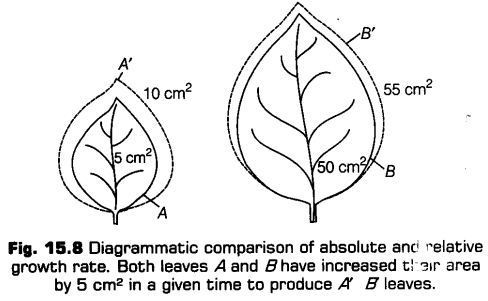
Leaves A and B shown in the figure have grown 5 cm2 in one day. Although their sizes are different, i.e., 5 cm2 and 50 cm2 respectively but both of them shows absolute increase in area in the given time to give leaves A and B, i.e., 5 cm2 in both cases. Out of these two the relative growth rate is higher or faster in leaf A.
Conditions or Factors for Growth
The growth of a plant is influenced by a variety of external and internal factors. Growth of plant involves synthesis of protoplasm, cell division, cell enlargement and cell differentiation.
Some of the factors due to which growth of plants is influenced are mentioned below
i. Water
It is the first and the foremost requirement of the plants for the enlargement of cell, maintaining turgidity of growing cells, for extension of growth. It also acts as a medium for many enzymatic activities. In water stress conditions growth of the plants seems to get retarded.
ii. Oxygen
It helps in releasing metabolic energy essential for growth activities.
iii. Nutrients
These acts as (macro and micro essential nutrients) major raw materials for protoplasmic synthesis and also acts as a source of energy. However, under nutrient deficient conditions the growth of the plant is affected.
Details of each and every essential nutrient has already been studied in chapter 12.
iv. Light
The requirement of the light to the plants for its growth is called photo-periodism. It helps in synthesis of food. It also determines the root and shoot growth. Along with light, gravity also serves as art environmental signal that affects certain phases/stages of growth.
v. Temperature
For normal and appropriate growth of plant optimum temperature range is necessary, i.e., 25-30°C (this happens because enzymatic reactions are very fast at optimum temperature range).
Differentiation, Dedifferentiation and Redifferentiation
Differentiation
During growth, meristematic cell divides by mitotic division to form daughter cells. The cells from root and shoot apical meristem, cambium or other meristems tends to differentiate and mature to perform specific functions. This act leading to maturation is known as differentiation.
e.g., Cell tends to loose their protoplasm, in order to form tracheary element. These cells also develop a very strong, elastic, lignocellulosic secondary cell wall in order to carryout water to long distance even under extreme conditions.
Dedifferentiation
The living differentiated cells also show another interesting phenomenon during which they regain the capacity to divide mitotically under certain conditions. The dedifferentiated cell can act as a meristem, e.g., Formation of meristems-interfasicular cambium and cork cambium from fully differentiated parenchyma cells.
Redifferentiation
The products of dedifferentiated.cells or tissue when lose the capacity to divide but mature taperform specific functions is known as redifferentiation, e.g, Secondary cortex and cork.
Parenchyma cells that are made to divide to form callus under controlled laboratory conditions are examples of dedifferentiated tissue. From the above discussion, it is very much clear that growth in plants is open in spite of differentiation shown by them.
It is so because cells/tissue that arise out of the single or same meristem shows different structures after attaining maturity. Thus, the final structure at maturity of a cell/tissue arising from the same tissue is also determined by the location of the cells, e.g, Cells positioned away from the root apical meristems differentiate as root cap cells, while those which are pushed to the periphery develops and matures as epidermis.
Development
It is the process that includes a series of changes that an organism goes through during its life cycle, i.e., from germination till senescence.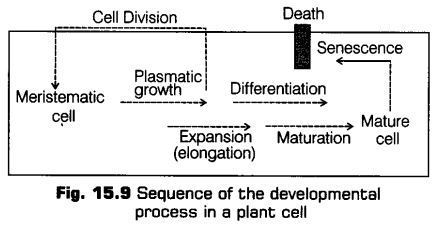
In broad terms development is the sum total of both growth and differentiation in plants.
The developmental process, of growth and differentiation is controlled by several intrinsic and extrinsic factors
(i) Intrinsic factors includes, both intracellular (genetic) or intercellular factors (such as plant growth regulators).
(ii) Extrinsic factors includes, light, temperature, water, oxygen, nutrition, etc.
Plasticity
Plasticity refers to a phenomenon in which plants follows different pathways in response to environment or phases of life forming different kinds of structures, e.g., Heterophylly, the phenomenon in plants by which more than two types of leaves occurs on the same plant.
Topic 2 Plant Growth Regulators
It has been suggested from sufficient evidences that the plants have certain chemical substances, which help to the control the mechanism of growth in the plant.
Plant growth regulators are variously described as plant growth substances, plant hormones or phytohormones. These are the small, simple organic molecules of diverse chemical composition produced naturally in higher plants that controls the growth and other physiological functions. These are required in a very small amount by the plant.
Classification of Plant Growth Regulators
The plant growth regulators falls under the following categories
(i) Indole compounds, e.g., Indole Acetic Acid (IAA)
(ii) Adenine derivatives, e.g., forfuryl amino purine, kinetin
(iii) Carotenoid derivatives, e.g., Abscisic acid (ABA)
(iv) Terpenes, e.g., Gibberellic acid (mainly )
(v) Gases, e.g., Ethylene .
On the basis of junctions they perform in a living plant body in broad terms, PGRs are divided into two groups
1. Plant Growth Promoters
PGRs that shows growth promoting activities such as cell division, cell enlargement, tropic growth, pattern formation, flowering, fruiting, seed formation, etc., are called plant growth promoters, e.g., auxins, gibberellins and cytokinins.
2. Plant Growth Inhibitors
These perform function in response to wounds and stresses i.e., of biotic and abiotic origin. These are also involved in various growth inhibiting activities like dormancy and abscission, e.g., Abscisic acid.
The gaseous form of PGR, i.e., ethylene, can fit in either category and may function both as promoter and inhibitor. But largely it functions as an inhibitor of growth activities.
Discovery of Plant Growth Regulators
It is interesting to know that the discovery of all five major groups of plant growth regulators have been done accidentally. All these help in understanding the phenomenon of development and abnormalbehaviour in plants.
1. Discovery of Auxin
This was the first growth hormone to be discovered. It come into existence through the observation of Charles Darwin and his son Francis Darwin.
They observed the coleoptiles of canary grass that responded to unilateral illumination by growing towards the source of light (phenomenon known as photo-periodism).
After performing series of experiments they came to the conclusion that coleoptile tip was the site that has the property of transmittable influence due to which bending of complete coleoptile was caused. The first PGR i.e., auxin was isolated by FW Went in 1928, from coleoptile tip of oat seedlings.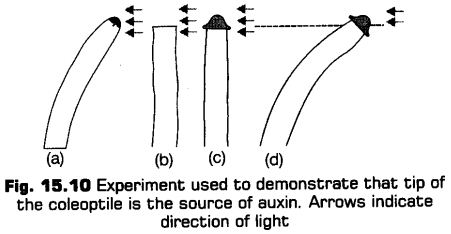
2. Discovery of Gibberellins
In early part of 20 century. The bakane (foolish seedlings), was reported to be caused by a fungal pathogen Gibberella fujikuroi, symptoms shown by the plant were elongated stems, little or no production of grains and plant became weak thus, it was later identified that the active substances was gibberellic acid.
The Japanist plant pathologist E Kurosawa, reported the appearance of symptoms of the disease in uninfected rice seedlings when they were treated with sterile filtrate of fungus.
3. Discovery of Cytokinins
F Skoog and his coworkers, while studying the nutritional requirements of tissue culture derived from the internodal segments of tobacco stems, observed that from that internodal segments, a callus (i.e., a mass of undifferentiated cells) proliferated, only when the nutrient medium containing auxin was supplemented with the extract of vascular tissues or yeast or coconut milk (water of endosperm of coconut) or DNA.
It was later found that the active substances were a modified form of adenine which was crystallised and identified as Kinetin. Further the compounds that exhibited kinetin like properties were termed as cytokinins.
4. Discovery of Abscisic Acid
With the progression in the research on plant growth regulators three independent researchers reported the purification and chemical characterisation of three different kinds of inhibitors (during mid I960), i.e., inhibitor B, abscission II and dormin. Later, three were proved to be chemically identical in nature and were named Abscisic Acid (ABA).
5. Discovery of Ethylene
Cousins (1910), confirmed the release of a volatile substance from ripened oranges that enhance the ripening of stored unripened bananas. This volatile substance was later identified to be a gaseous plant growth regulators, i.e., ethylene.
Physiological Effects of Plant Growth Regulators
Allfive categories of plant growtbregulators discussed above are described have under with their physiological effects on the growth of the plant
1. Auxins
Auxin (Gk. auxein to grow) was initially isolated from the urine of human, but later on, their presence was also found in plants and was proved to be the first PGR ever known. The real plant auxin is chemically known as Indole -3-Acetic Acid (IAA).
The term is also applied to other natural and synthetic compounds having various growth regulating properties. Production of auxin generally takes place in the region of growing apices of the stems and roots from where they migrates to the site of their action.
Auxins can move only through cell to cell by diffusion, i.e., they cannot move through vascular tissues.
Types of Auxins
There are generally two basic categories in which auxins are divided
a. Natural Auxins
It occur naturally in plants and fungi e.g., Indole Actic Acid (IAA) and Indole Butyric Acid (IBA).
b. Synthetic Auxins
These are prepared from synthetic compounds that causes several responses to IAA. They can easily move in all directions inside the plants, e.g., Naphthalene Acetic Acid (NAA), 2-4- dichlorophenoxyacetic acid (2, 4-D).
All these types of auxins are extensively been used in agricultural and horticultural practices.
Note:
* The compounds, which can be converted into auxins, are called auxin precursors, e.g., IAA is synthesised from tryptophan hormone.
* The compounds, which inhibit the actions of auxins, are termed anti- auxins.
* lndole-3 acetic acid is a derivative of an amino acid tryptophan.
Functions of Auxins
Auxins performs severaljunctions, these are as follows
(a) Cell Elongation Auxin stimulate the elongation of cells of shoots.
(b) Initiation of Roots In contrast to stem, higher concentration of auxin inhibits the elongation of shoots, but it initiates more lateral branches of roots.
(c) Inhibition of Abscission Natural auxins delay abscission of young fruits and leaves and also used to control pre-harvest fruit drop.
(d) Apical Dominance Presence of auxin in higher concentration (in higher plants) in shoot apex, promotes apical dominance. It is been seen commonly in many vascular plants, that presence of apical buds does not allow the lateral buds to grow. They only start developing into branches when the apical bud is removed.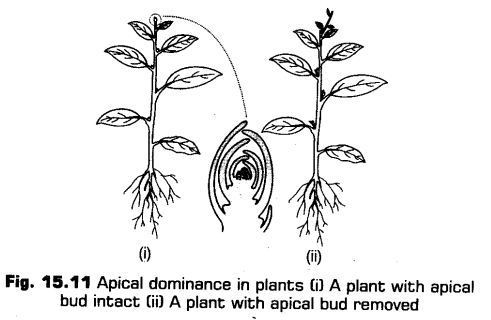
(e) Promotes Flowering Presence of auxin helps in promoting flowering in pineapple litchi, etc.
(f) Parthenocarpy Auxins are used to unpollinated pistil and make them develop into parthenocarps, which carry a better market value.
(g) Metabolism Application of auxin can enhance metabolism due to mobilisation of plant resources.
Applications of Auxins
As stated, use of synthetic auxins is widely accepted now-a-days in various agricultural and horticultural practices.
Following are the applications of auxins
(a) Eradication of Weeds Auxins are used as weedicides and herbicides. Application of 2, 4-dichlorophenoxyacetic acid (2, 4-D) is widely done in order to kill dicotyledonous weeds. It inflict does not affect mature, monocotyledonous plants.
The growth of lateral buds into branches after decapitation.
(b) Helps in Cell Division Besides cell elongation auxin may also be active in cell division.
(c) Controls Xylem and Phloem Differentia¬tion Auxin controls differentiation of xylem and phloem is stems and roots. There are evidences that low concentration of auxin induces phloem differentiation while higher concentration of auxin is responsible for differentiation of both xylem and phloem tissues.
2. Gibberellins
These are another kind of plant growth regulators, which are known to be weakly acidic growth hormones. There are more than 100 different gibberellins reported from widely different organisms like fungi and higher plants. All of them are known to be acidic in nature, . thus, they are termed as Gibberellic Adds (i.e„ GA , GA1 , GA2 and so on). However, GA3 is the most important gibberellic acid which was first to be discovered. It was most extensively studied.
Functions of Gibberellins
Gibberellins show various important physiological effects
(a) Elongation of Internodes It elongate the internodes so, as to increase the height of the plant. They cause an increase in length of axis and is also used in increasing length of grapes stalks.
(b) Elongation of Genetically Dwarf Plants It has been seen that if gibberellins are administered to a dwarf plant (pea, maize, etc), it may help in overcoming dwarfism. It also causes fruits to elongate and improve their shape, e.g., in apples etc.
(c) Bolting and Flowering The gibberellins also helps in promoting bolting (internode elongation) just prior to their reproductive phase or flowering. This is seen in rosette plants like beet, cabbage as these plants shows retarded internodal growth and profuse leaf development.
Rosette plants require either long days or cold night for bolting process and for the initiation of flowering.
(d) Breaking Dormancy It also helps in overcoming natural dormancy of buds, tubers, seeds, etc, and allows them to grow.
Seed Dormancy
The state of the seed is said to be the dormant state when it remains dry and non-germinating. Thus, by ‘breaking seed dormancy’, we simply mean, to make the seed to germinate.
(e) Flowering This can also be induced in long day plants by the action of gibberellins.
Applications of Gibberellins
Gibberellins, apart from showing varied .physiological effects, also have numerous application.
These are as follows
(a) Delays Senescence Gibberellins can delay the ripening of fruits such as Citrus fruits, apples, etc. This can be also used for safe and prolonged storage of the fruits.
(b) Malting Process The process of malting in brewing industry can be speedup by the use of GA3 .
(c) Sugar Yield As carbohydrate is stored in the form of sugar in the stems of sugarcane. Thus, if crop of sugarcane is sprayed with gibberellins. It results in increased length of the stem. This, enhance, increases the yield of sugarcane as much as 20 tonnes per acre.
(d) Early Seed Production like and when sprayed on juvenille conifers, hastens the maturity period of them leading to early seed production.
Cytokinins
These are growth promoters that are basic in nature. They have specific effects on cytokinesis (division of cytoplasm) and were discovered as kinetin (a modified form of adenine, a purine).
Lethometal (1964) while searching for a substance with cytokinin like activity isolated Zeatin from corn kernels and coconut milk. Now presendy, several naturally occurring cytokinins and some synthetic compounds having cell division promoting activities have been identified after the discovery of Zeatin.
Region of Synthesis of Cytokinins
Natural cytokinins are known to be synthesised in the regions where rapid cell division takes place, e.g., root apex, developing shoot buds, young fruits, etc., out of these roots are the major source of synthesis of cytokinins, from where, they move upwards through xylem.
Naturally Occurring Cytokinins
Coconut milk factor The liquid endosperm of coconut is known as coconut milk. This contains some factors, that shows kinetin like activity and enhance, stimulate the growth in many plant tissues (in vitro). All these factors are collectively called as ‘coconut milk factor’. These represents an example of naturally occurring cytokinins?
Zeatin It is also a naturally occurring cytokinin, isolated from maize grains. It is remarkably known to be more active than any other cytokinin.
Functions of Cytokinins
Cytokinins have following remarkable physiological effects
(a) Promotes cell division This is one of the most common and important biological effect of kinetin on plants, i.e., to induce cell division in the presence of sufficient amount of auxin (IAA).
(b) Reduces apical dominance They promote the growth of lateral buds by breaking apical dominance.
(c) Morphogenesis Differentiation or morphogenesis of plants tissues/organs is seen to be in control, if ratio of cytokinins and auxins is proportionate.
(d) Resistance They also increase resistance of plants to high or low temperature and diseases.
(e) Delays senescence These also helps in delaying senescence (ageing) of leaves and other organs by controlling synthesis of protein and mobilisation of resources or nutrients.
Applications of Cytokinins
(a) Tissue culture Cytokinins are essential for tissue culture; apart from cell division they are also involved in morphogenesis.
(b) Shelf life Administration of cytokinins to harvest fruits and vegetables keeps them fresh for several days and increase their shelf life.
Shelf life of flowers and cut shoots can also be increased by using cytokines.
4. Ethylene
It is a simple gaseous plant growth regulator, which is synthesized from the amino acid methionine. In plants synthesis of ethylene takes place in almost every part of the plant, i.e., roots, leaves, flowers, seeds, fruits, etc. Most important effect of ethylene is promotion of senescent changes in the plant. Thus, it is synthesized by tissue in large amounts that undergo senescence and also by ripening fruits due to this property it is also known as fruit ripening hormone.
As ethylene is a volatile substance, its production in one plant may influence the growth of other plants near to it.
Functions of Ethylene
Ethylene shows various important physiological effects
(a) In divot seedlings, ethylene influences the horizontal growth of seedling, swelling of the axis and formation of apical hook.
(b) It is highly effective in fruit ripening. It also increases the rate of respiration. This rise in the respiration rate is called respiratory climacteric.
(c) Helps in breaking seed and bud dormancy.
(d) Initiation of germination in peanut seeds and sprouting of potato tubers is also due to the
production of ethylene in plants.
(e) In deep water rice plants, ethylene promotes rapid internode petiole elongation.
(f) It proves to be helpful in increasing absorption surface of plants by promoting growth of root and formation of root hairs.
(g) It also stimulates flowering in fruits like pineapple, mango and other related plants.
Ethylene apart from so many positive responses also has negative feedback. Release of ethylene commonly inhibits the synthesis of auxins.
Applications of Ethylene
As ethylene helps in regulating these many physiological process in plants. It is known to be the most widely used PGR in agricultural field.
Ethephon It is the most widely used compound as a source of ethylene. This tends to absorbs readily in an aqueous solution and transported within the plant. This slowly releases ethylene.
(a) Ethephon is known to control fruit ripening (in tomatoes and apples).
(b) It also helps in accelerating abscission in flowers and fruits (causes thining of fruits like cotton, cherry, walnut, etc).
(c) Helps in promoting female flowers inhance, the yield of the fruits, e.g., Cucumber.
5. Abscisic Acid
It is slightly acidic growth hormone that functions as a growth inhibitor by interacting with other mentioned growth hormones, i.e., auxins, gibberellins and cytokinins.
Thus, like other PGR, abscisic acid also has a wide range of effects on growth and development of plants.
As its production is stimulated under stress (unfavourable conditions such as drought, water lodging, excessive temperature, etc). Thus, it is known as stress hormone. It acts antagonistically to gibberellic acid.
This hormone is transported to all parts of the plants through the process of diffusion by conductive channels.
Functions of Abscisic Acid
Abscisic acid shows various important physiological effects
(i) It has a primary role in regulating abscission and dormancy of buds and seeds. By inducing dormancy it helps the seeds to withstand the desiccation and other factors related to unfavorable growth.
(ii) It acts as a general plant growth inhibitor and also inhibits metabolism of plants.
(iii) It has its role in inhibition of seed germination.
(iv) Also plays an important role in seed development and maturation.
(v) Abscisic acid stimulates the closure of stomata.
Abscisic acid is also known as dormin as promotes several kinds of dormancy in plants.
The Mechanism of Stomatai Ciosmg by ABA
ABA binds to receptors of the plasma membrane at the surface of the guard cells.
The receptors in turn activate several interconnecting pathways, which causes a rise in pH in the cytosol promoting the transfer of Ca+2 from the vacuole to the cytosol.
All this causes stomata to close, and opening of stomata occurs when conditions are just reverse to it.
Interaction between Growth Regulators
For the regulation of every phase of growth, i.e., for differentiation and developmental processes in plants two or more phytohormones are intimately related to each other. These can either act synergistically or antagonistically.
Thus, every PGR has one or the other role to play. Likewise, there are also number of events in the life of a plant where more than one PGR is also involved to affect that particular event to takes place, e.g.,
(i) Dormancy of seeds and buds is mostly due to abscisic acid, while it is broken down by gibberellins.
(ii) Auxins and cytokinins acts antagonistically in controlling apical dominance, i.e., auxins causes apical dominance, while cytokinins helps to overcome them.
(iii) Senescence is prevented by both auxins and cytokinins, while its stimulation is done by abscisic acid.
(iv) Auxins and cytokinins acts synergistically in promoting cell division.
CBSE Class 11 Biology Chapter-15 Important Questions
1 Marks Questions
1.What is growth?
Ans. Irreversal permanent increase in size of an organism.
2.Which hormone act as “stress hormone”?
Ans. Abscisic acid (ABA)
3.Name a non-acidic growth substance.
Ans. Kinetin.
4.What is aleurone layer?
Ans. It is special tissue layer which surrounds the endosperm in maize grain.
5.Name the growth regulator which was first isolated from corn kernel and coconut milk?
Ans. Zeatin (Cytokinin) was first isolated from corn kernel and coconut milk.
6.What is the full form of IAA?
Ans. Indole Acetic Acid.
7.Name the hormone which is responsible for elongation of intermodal regions of green plants.
Ans. Ethylene
8.Would a defoliated plant respond to photoperiodic cycle? Why?
Ans. No as the site of perception is the leaves so it will not respond to photoperiodic cycle.
9.Mention the names of two such substances that cause seed dormancy?
Ans. Abscissic acid and phenolic acid.
10.Write the cause of ‘Bakane’ disease of rice.
Ans. Gibberalla fujikuroi.
11.Name the plant hormone which was first is from human urine.
Ans. Auxin
12.Name the only gaseous & plant hormone.
Ans. Ethylene
13.How does abscise acid acts as stress hormone in drought condition
Ans. ABA causes rapid closure of stomata, preventing loss of water by transpiration.
14.A famer observed some broad-leaved weeds in a wheat crop farm. Which plant hormone would you suggest remove them?
Ans. 2.4-D
15.Why do lateral buds start developing into branches whena apical bud is removed?
Ans. Due t0 inhibit activity of Auxin lateral growth starts.
16.Flowering in certain pIant occur only when they are expos to low temperature for a few weeks. name this phenomenon.
Ans. Vernalisation
17.Name the hormone released from over-ripe that affects all other apples in a small wooden box.
Ans. Ethylene.
2 Marks Questions
1.What would happen to tissue culture of parenchyma if-
a) Auxin and cytokinin were present in equal quantities.
b) More cytokinin than auxin was present.
c) More auxin than cytokinin was present
Ans. i) cells divide but do not differentiate
ii) shoot buds develop from the callus.
iii) Root develop.
2.Define vernalization?
Ans. The term vernalization is promoter of flowering by a previous cold treatment. In flowering plant, plants requiring cold treatment usually behave as biennials. They germinate and grow vegetative in first season and produce flower in second season.
3.What is heterophylly?
Ans. The plants follow various pathways in response to environment / phase of life to form different kind of structures. It is known as plasticity. Some examples are heterophylly in cotton, coriander and larkspur. The leaves of juvenile plants are different in shape from those in mature plant. Difference in the shapes of leaves produced in air and those produced in water in buttercup also represent the heterophyllous development due to environment. The phenomenon of heterophylly is an example of plasticity in plants.
4.‘Both growth and differentiation in higher plants are open’ comment.
Ans. Growth and differentiation in plants are open as all the cells as well as the tissues arising from the same meristem may possess different structures at maturity. The maturity is determined by the location of cells or tissues e.g. it may be at shoot apex, root apex. Cambium etc.
5.What is bolting? Which hormone is responsible for it?
Ans. Enormous elongation of inter nodes resulting increase in stem height. Gibberellins cause the plants to bolt and flower.
6.Why is the term short plants a misnomer?
Ans. These plants require a relatively short day light period usually 8-10 hours and a continous dark period of about 14-16 hours for flowering. In short day plants dark period is critical and must be continuous. They are known as long Night plants and the term short day plant is a misnomer with long night plants.
7. Explain the role played by phytohormone in seed germination.
Ans. It is a regulatory pigment which controls several light dependent developmental processes in plants besides seed germination. Phytohormones exist in two inter convertible forms : Pr and Pfr. On absorbing red light Pr becomes Pfr and Pfr becomes Pr either rapidly by absorbing far red light or slowly in darkness. Germination is promoted by Pfr and red light is needed to promote this. Darkness (far-red) promotes Pr formation which induces dormancy and inhibits germination.
8.What is ‘Bioassay’?
Ans. A bioassay is the evaluation of the effect of a substance on living organism under controlled conditions.
9.Name any two synthetic auxins. How are they used in agriculture.
Ans. Two synthetic auxins are
(i) Naphthalene Acetic Acid (NAA)
(ii) In dole Butyric Acid (IBA)
They are used as weedicides
10. How will you induce lateral branching in a plant which normally does not p them? Give reason.
Ans. When apical bud is removed, lateral branches are produced. Removal of apical bud affect the auxin is destroyed inducting the lateral buds to grow rapidly.
11. What is meant by abscission ? Name the phytohormone involved in it.
Ans.
• Premature fall of leaf and fruit is called abscission.
* Abscisic acid
3 Marks Questions
1.What are the conditions necessary for growth?
Ans. The necessary conditions for growth are water, oxygen and nutrients. The plant cell grows in size by cell enlargement that needs water. The plant growth and further development are intimately liked to water status of plants. Water provides medium for enzymatic activities needed for growth O2 helps in releasing metabolic energy for growth. Nutrients both macro and micro essential elements are needed by plants for synthesis of the protoplasm. Moreover, they act as source of energy.
Every plant has an optimum temperature range best suited for its growth. Any deviation from it may be detrimental to its survival. Environmental signal like light and gravity also influence various phases or stages of growth in plaints.
2.What does the sigmoid growth curve of a population mean?
Ans. In biological organization growth occurs at many levels, from the molecular level upto the ecosystem level. It can be measured at different levels such as the growth of cell organism or population. If it is measured in length, area, volume, mass or number of cells or individuals and plotted against time, and s-shaped curve is obtained. This is known as sigmoid curve. An analysis of this curve shows a lag phase during which slow growth occurs. This gradually attains a rapid growth, followed by a period of slow growth and ultimately a decline called stationary phase. Since the same patterns of growth is sigmoid curve observed at all levels of organization it is said to be universal.
3.Differentiate between photoperiodism and vernilisation?
Ans.
| Photoperiodism | Vernilization | |
| a | Photoperiodism is the flowering response of the plants to the duration of light and dark period in the diurnal cycle. | Vernalisation prepares the plants for perceiving stimulus for flower induction by chilling treatment. |
| b | In this stimulus perceived by green leaves only. | Stimulus is perceived by young embryos, meristems and even leaves. |
| c | In this florigen is produced under photoinductive conditions. | Vernalin is produced by chilling treatment. |
| d | Photoperiodic induction cannot be reversed by exposing to non-inductive conditions. | Vernalisation can be reversed when maintained higher temperature |
| e | GA3 has the capability to replace the requirements of photo-inductive conditions in long day plants only. | GA3 can replace cold treatment to induce vernalisation. |
4.Discuss the statement : ‘The growth is measurable’
Ans. The growth (at a cellular level) is basically a consequence of increase in the amount of protoplasm. Since we cannot measure growth directly it is measured by some quantity that is more or less proportional to it so the growth is measured by a variety of parameters like increase in fresh weight; dry weight; length; area; volume and cell number etc. One single maize root apical meristem may give rise to more than 17,500 new calls per hour. The cells in a watermelon can increase in size by upto 3,50,000 times. Therefore, growth may be expressed as increase in cell number or as increase in size of cell. The growth of a pollen tube is measured in terms of length. An increase in surface area measures growth in a dorsiventral leaf or dicot leaf.
5.What is apical dominance name the hormone that controls it.
Ans. “The inhibition of growth of lateral buds into the branches in the presence of an apical bud.”
Apical dominance is under the control of auxins IAA (indole acctic acid) is the principal auxin found in all the plants. Lateral buds start their development when apical bud is removed. The process is again reversed if you apply IAA to decapitulate apex of plant.
6.Write the principal characteristics of PGR’s.
Ans. Characteristics – PGRs are small, simple molecules of diverse chemical structure occurring in plants. They are indole compounds (indole 3 acetic acid, IAA); adenine derivatives CN6 of (arotenoids) and the fatty acids (abscisic acid, ABA); terpenes (gibberllic acid, GA3) or gases (ethylene, C2H4). PGR’s are called plant growth substances or plant hormones.
They are broadly divided into two groups based on their function in a living plant body:-
a) On group of PGR’s involved in growth promoting activities, e.g, cell division, cell enlargement, pattern formation, tropic growth, flowering, fruiting and seed formation. They also termed plant growth promoter e.g. auxons, gibberellins, cytokinins.
b) PGR’s of other group are in plant responses to wounds and stresses of biotic and abiotic origin. These may be involved in different growth inhibiting activities like dormancy and abscission; e.g, abscissic acid (ABA). The gaseous PGR is ethylene. It is inhibitor of growth activities mostly.
7. What would be expected to happen if :
(a) GA3 is applied to rice seedling.
(b) a rotten fruit get mixed with unripe fruits.
(r) you forget to add cytokinin to the culture medium.
Ans. (a) Hyper elongation of internodes of rice seedlings will occur.
(b) Unripe fruits will lea to early ripening and ultimately it will result in rottening.
(c) Short but formation will not occur.
5 Marks Questions
1.What is photoperiodism? How do you categories the angiosperms on the basis of their flowering response.
Ans. Photoperiodism – The phenomenon of inducing flowering in plants with response to length of daily period of light or relative day & night length is call photoperiodism.
The angiosperms are classified into the following three categories on the basis of photoperiodism.
(i) short day plants (SDP) – They require a relating short day length than critical period for flowers e.g chrysanthemum, Nicotiana, soyabean.
(ii) Long day plants (LDP) – They require a relating longer day length than critical period for flowing e.g. wheat, Maize, Radish.
(iii) Day neutral Plants (DNP) – The flowering response in their plants remain unaffected by the length of day. These plants are also called as photoneutrals or indifferent plants e.g. Cotton, Pea, Tomato & sunflower.
2. i) What do you understand by the tem Development?
ii)Explain the sequence of development process in a plant cell.
Ans. It is a term “that includes all changes that an organism goes through during its life cycle from germination of the seed to senescence.” Diagrammatic representation of the sequence of processes in development of a cell of a higher plant.
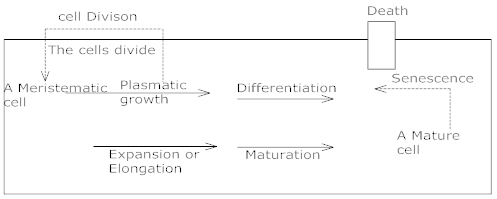
Sequence of the development process in a plant cell.
3.How is growth measured in plants?
Ans. Growth in plants is measured by are indicator arc auxanometer. Pfeffer’s auxanometer have two wheels attached to a stem. The lip of the potted plant is connected to small pulley and its other end is strengthened to a weight. A pointer is attached to a big pulley by weight and also to a cylinder having smoothed paper.
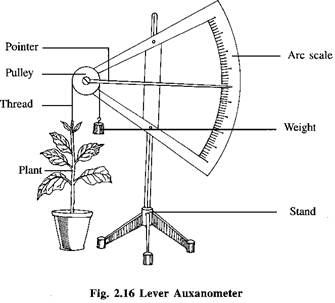
NCERT TEXTBOOK QUESTIONS FROM SOLVED
1. Define growth, differentiation, development, dedifferentiation, redifferentiation, determinate growth, meristem and growth rate.
Solution: Growth is defined as a vital process which brings about an irreversible and permanent change in the shape, size, form, weight and volume of a cell, organ or whole organism, accompanied with increase in dry matter.
Differentiation is a localised qualitative change in size, biochemistry, structure and function of cells, tissues or organs, e.g., fibre, vessel, tracheid, sieve tube, mesophyll, leaf etc. Thus it is a change in form and physiological activity. It results in specialisation for particular functions.
Development may be defined as a process which includes growth, differentiation and maturation in a regular sequence in the life history of a cell, organ or organism viz., seed germination, growth, differentiation, flowering, seed formation and senescence. Dedifferentiation is the process by which the differentiated cells which have lost the ability to divide under certain circumstances, become meristematic and regain the divisibility. Redifferentiation is defined as maturation or differentiation of dedifferentiated cells to form cells which are unable to divide e.g., secondary xylem elements, cork cells etc., are formed by redifferentiation of secondary cambial cells.
Determinate growth is the ability of a cell, tissue or the organism to grow for a limited period of time. Meristem is a tissue consisting of unspecialised immature cells, possessing the power of continuous cell division and adding new cells to the body. Growth rate is defined as the increased growth per unit time.
2. Why is not any one parameter good enough to demonstrate growth throughout the life of a flowering plant?
Solution: A flowering plant consists of a number of organs viz., roots, stem, leaves, flowers, fruits etc. growing differently under different stages of life cycle. These plant organs require different parameters to demonstrate their growth. In plant organs like fruits, bulbs, corms etc. fresh weight is used for measuring their growth. In case of fruits, increase in volume, diameter etc., are also used as other parameters for the measurement of their growth. For flat organs like leaves, increase in surface area is used as the parameter. Stem and roots primarily grow in length and then in girth, thus increase in length and diameter are used for measuring their growth. Consequently, the flowering plants exhibit several parameters to demonstrate growth.
3. Describe briefly
(a) Arithmetic growth
(b) Geometric growth
(c) Sigmoid growth curve
(d) Absolute and relative growth rates
Solution: (a) Arithmetic growth: If the length of a plant organ is plotted against time it shows a linear curve, the growth is called arithmetic growth. In this growth, the rate of growth is constant and increase in growth occurs in arithmetic progression e.g., length of a plant is measured as 2,4, 6, 8,10,12 cms at a definite interval of 24 hrs. It is found in root or shoot elongating at constant rate. Arithmetic growth is expressed as Lt = L0 + rt Here, Lt = length after time t. L0 = length at the beginning, r = growth rate.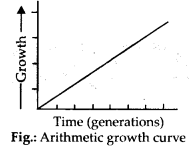
(b) Geometric growth: Geometric growth is the growth where both the progeny cells following mitosis retain the ability to divide and continue to do so. It occurs in many higher plants and in unicellular organisms when grown in nutrient rich medium. Number of cells is initially small so that initial growth is slow which is called lag phase. Later on, there is rapid growth at exponential rate. It is called log or exponential phase.
(c) Sigmoid growth curve: Geometric growth cannot be sustained for long. Some cells die. Limited nutrient availability causes slowing down of growth. It leads to stationary phase. There may be actually a decline. Plotting the growth against time will give a typical sigmoid or S-curve.
S-curve of growth is typical of most living organisms in their natural environment. It also occurs in cells, tissues and organs of plants.
(d) Absolute growth rate is the measurement of total growth per unit time. Relative growth rate is growth per unit time per unit initial growth.
Growth in given time period/ Measurement at start of time period
Suppose two leaves have grown by 5 cm2 in one day. Initial size of leaf A was 5 cm2 while that of leaf B was 50 cm2. Though their absolute growth is the same (5 cm2/day), relative rate of growth is faster in leaf A(5/5) because of initial small size than in leaf B(5/50).
4. List five main groups of natural plant growth regulators. Write a note on discovery, physiological functions and agricultural/ horticultural applications of any one of them.
Solution: There are five main groups of natural plant growth regulators which are very much recognised as natural hormones in plants. These are:
- Auxins
- Gibberellins
- Cytokinins
- Abscisic acid
- Ethylene
Discovery of auxin: In 1880, Charles Darwin and Francis Darwin worked with the coleoptile of canary grass (Phalaris sp.) and found the existence of a substance in coleoptile tip, which was able to recognise the light stimulus and leads to the bending of tip towards light. Boysen and Jensen (1910-1913) worked on Avena seedling and explained that the substances secreted in the tip are soluble in water (gelatin).
Paal (1919) reported that the substances secreted in the tip are translocated downwards and caused cell elongation in half portion which was on the dark side and hence bending was observed in opposite direction.
F.W. Went (1928) further refined this experiment and supported the observations of Paal. He was the first person to isolate and name these substances of tip as auxins (Greek Auxein – means ‘to grow’).
In 1931, Kogl and Haagen-Smith isolated
crystalline compounds from human urine.
These were named as auxin-a, auxin-b and
heteroauxin.
Physiological functions of auxins:
- Auxins induce cambial cell divisions, shoot cell elongation and early differentiation of xylem and phloem in tissue culture experiments.
- In general, auxins initiate rooting but inhibit the growth of roots. IBA is the most potent root initiator.
- Auxins inhibit the growth of axillary buds (apical dominance) but enhance the size of carpel and hence earlier fruit formation.
- Application of auxins retards the process of senescence (last degradative phase), the abscission of leaves, fruits, branches, etc.
- Auxins induce feminisation, i.e., on male plant, female flowers are produced.
Agricultural/horticultural application of auxins:
- Application of auxins like IAA, IBA, NAA induce rooting in stem cuttings of many plants. This method is widely used to multiply several economically useful plants.
- Normally, auxins inhibit flowering however in litchi and pineapple, application of auxin promotes flowering thus used in orchards.
- Auxin induces parthenocarpy in some plants including tomato, pepper, cucumber and Citrus, thus, produces seedless fruits of more economic value.
- Auxins like 2, 4-D and 2, 4, 5-T are commercially used as weedicides, due to their low cost and greater chemical stability. They are selective herbicides (killing broad-leaved plants, but not grasses).
- For checking premature fruit drop, auxins are applied which prevent the formation of abscission zone in the petiole or just below the fruit. Auxin regulates maturing fruit on the trees of apples, oranges and grape fruit. High doses of auxins can
cause fruit drop. Thus, heavy applications of synthetic auxins are used commercially to promote a coordinated abscission of various fruits to facilitate harvesting. - Auxin, produced in the apical bud, suppresses the development of lateral buds, i.e., apical dominance. Thus practically used in prolonging the dormancy period of potato tubers.
- Naphthalene acetamide is used to prevent the lodging (excessive elongation and development of weak plants, specially in gramineae) or falling of crops.
- Auxin (2,4-D) promotes callus formation in tissue culture. Complete plantlets are regenerated from callus tissue, using auxins and cytokinin which are then transplanted into the soil. Now-a-days, this is a widely practised method of propagation in the field of agriculture and horticulture.
5. What do you understand by photoperiodism and vernalisation? Describe their significance.
Solution: The physiological mechanism for flower-ing is controlled by two factors: photoperiod or light period, i.e., photoperiodism and low temperature, i.e., vernalisation. Photoperiodism is defined as the flowering response of a plant to relative lengths of light/ dark period. Significance of photoperiodism is as follows:
- Photoperiodism determines the season in which a particular plant shall flower. For example, short day plants develop flowers in autumn-spring period (e.g., Dahlia, Xanthium) while long day plants produce flowers in summer (e.g., Amaranthus).
- Knowledge of photoperiodic effect is useful in keeping some plants in vegetative growth (many vegetables) to obtain higher yield of tubers, rhizomes etc. or keep the plant in reproductive stage to yield more flowers and fruits.
- A plant can be made to flower throughout the year by providing favourable photoperiod.
- Helps the plant breeders in effective cross-breeding in plants.
- Enable a plant to flower in different seasons.
Vernalisation is promotion or induction of flowering by exposing a plant to low temperature for some time. Significance of vernalisation is as follows :
(i) Crops can be grown earlier.
(ii)Plants can be grown in such regions where normally they do not grow.
(iii)Yield of the plant is increased.
(iv)Resistance to cold and frost is increased.
(v) Resistance to fungal diseases is increased.
6. Why is abscisic acid also known as stress hormone?
Solution: A fairly high concentration of abscisic acid (ABA) is found in leaves of plants growing under stress conditions, such as drought, flooding, injury, mineral deficiency etc. It is accompanied by loss of turgor and closure of stomata. When such plants are transferred to normal conditions, they regain normal turgor and ABA concentration decreases. Since the synthesis of ABA is accelerated under stress condition and the same is destroyed or inactivated when stress is relieved, it is also known as stress hormone.
7. ‘Both growth and differentiation in higher plants are open’. Comment.
Solution: Plant growth is generally indeterminate. Higher plants possess specific areas called meristems which take part in the formation of new cells. The body of plants is built on a modular fashion where structure is never complete because the tips (with apical meristem) “are open ended – always growing and forming new organs to replace the older or senescent ones. Growth is invariably associated with differentiation. The exact trigger for differentiation is also not known. Not only the growth of plants are open- ended, their differentiation is also open. The same apical meristem cells give rise to different types of cells at maturity, e.g., xylem, phloem, parenchyma, sclerenchyma fibres, collenchyma, etc. Thus, both the processes are indeterminate, unlimited and develop into
different structures at maturity i.e., both are open.
8. ‘Both a short day plant and a long day plant can produce flower simultaneously in a given place’. Explain.
Solution: A short day plant (SDP) flowers only when it receives a long dark period and short photoperiod, e.g., Xanthium, Dahlia etc. On the other hand, a long day plant (LDP) will flower only when it receives a long photoperiod and short dark period, e.g., wheat, oat etc. Thus critical photoperiod is that continuous duration of light which must not be exceeded in SDP and should always be exceeded in LDP in order to bring them to flower. Xanthium requires light for less than 15.6 hrs and Henbane requires light for more than 11 hrs. Xanthium (a SDP) and Henbane (DP) will flower simultaneously in light period between 11 to 15.6 hrs.
9. Which one of the plant growth regulators would you use if you are asked to
(a) induce rooting in a twig
(b) quickly ripen a fruit
(c) delay leaf senescence
(d) induce growth in axillary buds
(e) ‘bolt’ a rosette plant
(f) induce immediate stomatal closure in leaves.
Solution: (a) Auxins like IBA, NAA.
(b) Ethylene
(c) Cytokinins
(d) Cytokinins
(e) Gibberellins
(f) Abscisic acid (ABA)
10. Would a defoliated plant respond to photo- periodic cycle? Why?
Solution: No, a defoliated plant would not respond to photoperiodic cycle because photoperiodic stimulus is picked up by the leaves only. Even one leaf or a part of it is sufficient for this purpose. For perception of photoperiodic cycle, there must be the presence of leaves under inductive photoperiod, so that, the hormone responsible for flowering can be produced.
11. What would be expected to happen if:
(a) GA3 is applied to rice seedlings
(b) dividing cells stop differentiating
(c) a rotten fruit gets mixed with unripe fruits
(d) you forget to add cytokinin to the culture medium.
Solution:
(a) The coleoptile will elongate rapidly, as GA3 helps in cell growth.
(b) The development of callus (mass of undifferentiated cells) will take place.
(c) The unripe fruits will ripe quickly because of the increased rate of respiration due to emission of ethylene from rotten fruit.
(d) Cell division will retard and shoot will not initiate from the callus.